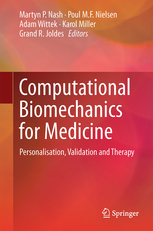Computational Biomechanics for Medicine XIII
A MICCAI 2018 Workshop, Granada, Spain, 2018 September 16
Home | Organisers | Important
Dates | Scope | Registration
| Submissions
Rationale:
 Mathematical modelling and computer simulation have had a profound impact on science and proved tremendously successful in engineering.
One of the greatest challenges for mechanists is to extend the success of computational mechanics beyond traditional engineering,
in particular to medicine and biomedical sciences. The Computational Biomechanics for Medicine workshops provide an opportunity for
researchers to present and exchange ideas on applying their techniques to computer-integrated medicine,
which includes MICCAI topics of Medical Image Computing, Computer-Aided Modeling and Evaluation of Surgical Procedures,
and Imaging, Analysis Methods for Image Guided Therapies, Computational Physiology, and Medical Robotics. For example, continuum mechanics
models provide a rational basis for analysing medical images by constraining the solution to biologically plausible motions and processes.
Biomechanical modelling can also provide clinically important information about the physical status of the underlying biology,
integrating information across molecular, tissue, organ, and organism scales.
Mathematical modelling and computer simulation have had a profound impact on science and proved tremendously successful in engineering.
One of the greatest challenges for mechanists is to extend the success of computational mechanics beyond traditional engineering,
in particular to medicine and biomedical sciences. The Computational Biomechanics for Medicine workshops provide an opportunity for
researchers to present and exchange ideas on applying their techniques to computer-integrated medicine,
which includes MICCAI topics of Medical Image Computing, Computer-Aided Modeling and Evaluation of Surgical Procedures,
and Imaging, Analysis Methods for Image Guided Therapies, Computational Physiology, and Medical Robotics. For example, continuum mechanics
models provide a rational basis for analysing medical images by constraining the solution to biologically plausible motions and processes.
Biomechanical modelling can also provide clinically important information about the physical status of the underlying biology,
integrating information across molecular, tissue, organ, and organism scales.
The main goal of this workshop is to showcase the clinical and scientific utility of computational biomechanics in computer-integrated medicine.
Previous workshops in the series.
Program:
The workshop programme is available for download here.
Invited speaker:
Professor of Structural Mechanics and Biomechanics, University of Porto
Title: "Biomechanical simulation of vaginal childbirth: the colors of the pelvic floor muscles"
Abstract
Childbirth-related pelvic floor damage is an issue that has been much studied mainly due to the dysfunctions that can arise from childbirth-related traumas, such as urinary and/or anal incontinence, and pelvic organ prolapse. In fact, vaginal delivery is the greatest epidemiological risk factor for the development of pelvic floor disorders (PFD). During birth all women sustain stretching of their pelvic floor, however it can be verified that in some cases they also experience an amount of injury that is related with the development of PFD. Elucidating the pregnancy mechanisms and the impact of vaginal delivery in pelvic floor muscles can lead to the development of preventive and therapeutic strategies to minimize the most common injuries.

